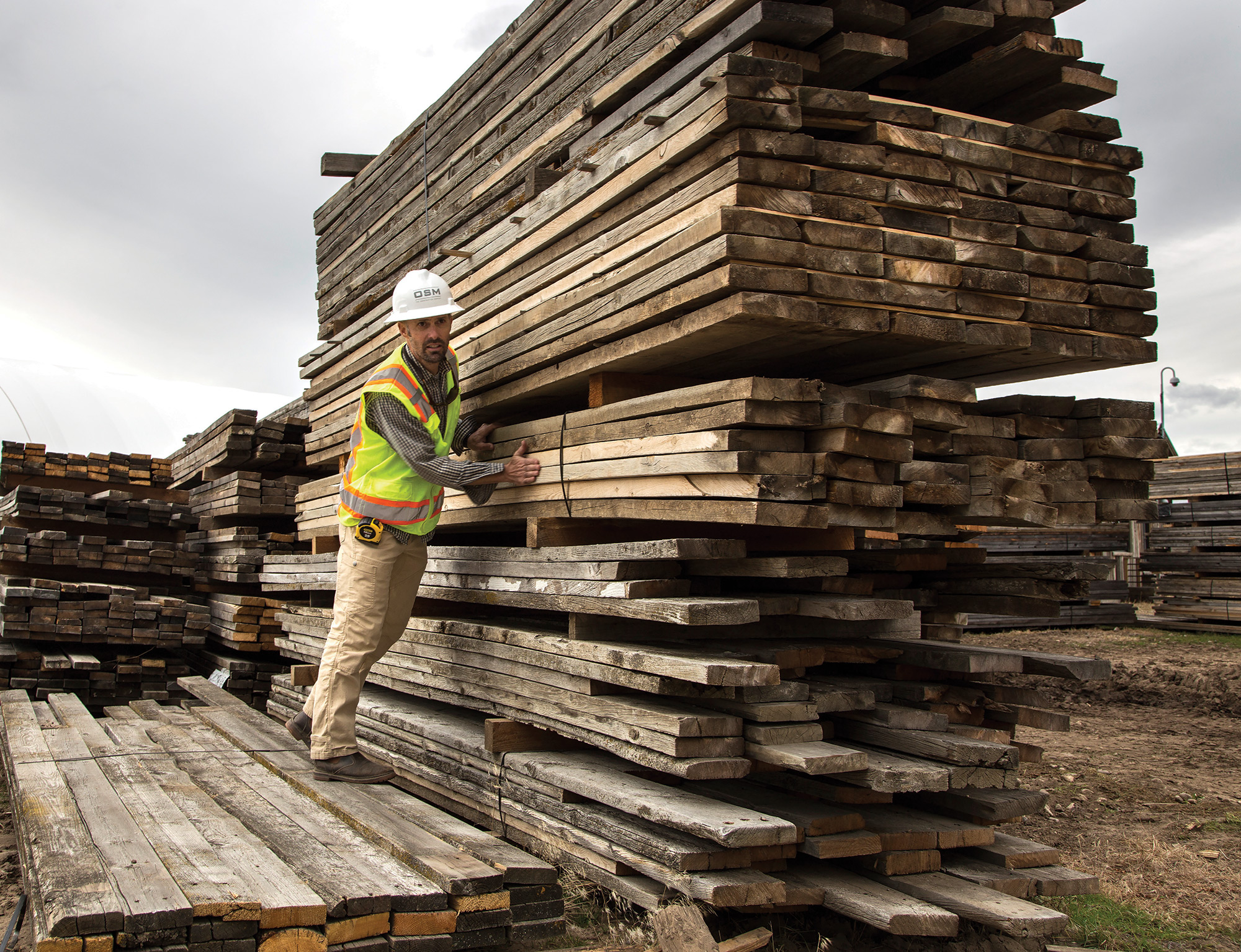
14 Apr Behind the Boards
A little more than 40 years ago (call it 1974 or 1975), Jonathan Foote had a conversation with his brother, Geoff. Jon Foote was an up-and-coming architect then based in New England. And while he had some admirable East Coast bona fides on his CV (Yale and the Rhode Island School of Design), he was already starting to look west. “Geoff said he was thinking about building a house on his property near Ovando, Montana,” said Foote, who is now 82. “I told him, I said, that sounds like fun. I’d like to help. Then my brother had the idea, do you think we could use some of these old homestead cabins on the ranch?”
Sure. Sure they could. And so the brothers Foote proceeded to disassemble the cabins and repurpose a good portion of the timbers back into Jonathan’s new design. A client in Jackson, Wyoming, soon followed asking for the same look. Then came a magazine article. Foote set up shop in Livingston, Montana. Fast forward a generation or two, and reclaimed lumber, in the context of residential architecture, has become something very nearly unique to the Northern Rockies. If this isn’t our signature style, it’s as close as we’re likely to get. New England has the Cape Cod; Santa Fe has Pueblo Revival; Montana, Wyoming, and Idaho have reclaimed. It’s no stretch to say that the look popularized by Foote has informed thousands of homes in the region (Foote himself is responsible, by his own count, for more than a hundred projects), and most of these structures seem to have sprung from the landscape itself.
Weathered timbers, dry-stack stone, and contrasting textures. It’s a visual vocabulary that speaks first to understated authenticity. If you’re a landowner who can write these kinds of checks, using reclaimed is a way of bending a knee to the past even while building something new. You can blend in and set yourself apart. Foote likes to quote one of his mentors, architect Lou Kahn: “A material wants to be used in a way that it can be itself.”
These days, reclaimed lumber is an industry unto itself. In order for a given board to make it from its original context to a new home, it needs the support of a very specialized infrastructure. The source material needs to be discovered, disassembled, transported, denailed, cleaned, resawn as necessary, stacked, graded, and sorted. It’s improbable, the amount of work and care that goes into curating a single board.
And, as it happens, Montana’s Gallatin Valley is the epicenter of it all, home to three significant reclaimed lumberyards. Varying in size, sources, and customer base, these three yards demonstrate considerable differences, but offer some obvious commonalities as well: denailing stations and metal detectors, saws and drying kilns, power sprayers and college-age employees working over claw hammers. And they all are managed by individuals with a passion for the wood. It’s a considered word: passion. And not just for the quality of the wood but for the narratives behind the wood. It’s one of the things the customer buys, after all. A piece of paneling, a railing, a rafter, sure; but also the context. Where it came from. It makes for something to talk about over the second glass of wine.
Two of the reclaimed yards in Gallatin Valley were originally founded by, and used as suppliers for, specific builders. Not far from Belgrade, Montana, Chris McQueary is one of the managers for On Site Management (OSM), a business originally created by Jonathan Foote (although Foote is no longer directly involved). On an overcast day last fall, McQueary stopped at a pile of large timbers, rough with the marks of an ax. “These are hand-hewn beams. Came from a barn out of Ohio. You can see how they were whitewashed at one point, which usually means dairy farm.” He pointed to two different styles of hewing, one of them with cleaner ax marks, smoother and further apart. “Whoever finished these logs, this person was a lot more skilled, and had sharper tools, than that person.”
For a given board to make it from the side of a dilapidated barn to the face of a high-end cabinet or panel, it begins either with a specific request from a customer, architect, or designer, or with a good, previous acquisition. Suppliers who salvage lumber from industrial and agricultural structures, along with a number of middlemen resellers, help the yards find and maintain their inventory. “If a request comes in,” McQueary said, “I’m going to know a supplier that can help me fill the request. Either that, or I’m going to get on a plane myself.”
Twenty years ago, the bulk of the supply for regional reclaimed lumber came from the Northern Rockies. But that’s changed. “This is American chestnut from Johnstown, Pennsylvania,” McQueary said, showing me a stack of weathered boards. “We hired a Mennonite crew to go in and salvage it for our inventory.” Then later: “These antique joists came out of a historic, dilapidated hotel in San Francisco. We’re actually in the process of rejecting a portion of it from the supplier. Not because of the nails but because of the excessive holes we found after sorting through. The original electrical contractor drilled holes in the boards to run the electric.”
OSM regularly works with 10 different suppliers. Among their inventory streams is a contract with the State of Montana to build and maintain the state’s snow fencing: They trade out the boards every seven years or so, creating a steady, predictable supply of gray planks. These suppliers also keep a stream of corral boards coming in the door. McQueary ran his hands over a smoother, slightly concave section of corral board. “See that? That’s from the neck of the cow rubbing it.”
Moving through their stacks, past an endloader and a sorting and cleaning station, McQueary said, “We start out by asking clients a set of questions. We ask them, ‘Do you want a naturally aged gray or brown?’” Gray being lumber which was weathered outside and brown having been aged on the inside. “Then, ‘Do you want hand hewn? Do you want rough sawn or smooth?’ Then the species start coming into play. ‘Do you want oak? Fir?’” Above all, most clients want consistency, a similar look across the boards — this from a material which is full of inconsistencies. It’s something that every reclaimed provider works hard to achieve.
Five or six miles down Jackrabbit Lane toward Four Corners, Schlauch Bottcher Construction (SBC) is the parent company of Montana Timbers. In business for 20 years, SBC created Montana Timbers as a way to control its own supply and schedule. At this point, however, and according to operations manager Pat Iwanski, a good portion of the yard’s inventory goes out to other architects and builders. A showroom gives potential customers a look at samples. You can pick up a board, weigh it in your hands, snap a photo, be told how much it’s going to set you back.
“There’s about a million board feet in this facility,” Iwanski said, walking through their yard, “and we’re a completely metal-free facility. The boards are denailed as soon as they come off the truck.” The yard was sloppy after an early snowstorm and thaw. Our boots sank into half-frozen mud.
Iwanski, as I learned, oversees a crew of eight, but does most of the finding and selling himself, working with suppliers and contractors. “There’s not a lot of competition for customers in this business,” he said, “but there is definitely competition for the resource. We’re competing for the materials.” He grinned a little. “It’s kind of like bass fishing. The suppliers are going to show off their fish, but they’re not going to tell you about their favorite fishing holes.”
Iwanski has worked with wood, some form or another, for most of his career. Talking about the inventory in his yard, he bounces between matter-of-fact professionalism and the excitement of an enthusiast. “These beams came out of an army base warehouse in Oakland. I think it was built in 1942 or ’43. There were five different reclaimed guys competing for the wood down there. They chopped and divided it into something like 90 semi loads. This beam’s already sold. It’ll be a ridge beam in a private residence up Bridger Canyon.”
Montana Timbers operates three kilns, and offers milling services (including a moulder). “Tongue and groove is a big part of our business,” Iwanski said. Their inventory includes pieces from a Fruit of the Loom warehouse in Alabama, a cannery in San Jose, California (“We had nine semi loads come out of San Jose”), shipyards in Tacoma, Washington, and the old Lehrkind Brewery in Bozeman. “We’ve saved these,” he said about the Lehrkind boards. “Set them aside. If somebody really wants a part of Bozeman history…”
All three of the yards I toured had some residual wood that the managers weren’t anxious to sell. It felt like a problem. Balancing your passion for the wood against the necessity of moving it out the door. For Iwanski, while he was clearly proud of the graffiti-covered boards from a warehouse in Compton, he lingered longest over the 52-foot beams from a mill out of Grants Pass, Oregon. “We’ve had these forever. I just can’t bring myself to get rid of them.”
Montana Reclaimed Lumber Co. (MRL) was founded to supply reclaimed lumber to the public. Mike Halverson was working construction in 1997 when his foreman asked for volunteers to take down a granary outside of Bozeman. “I said, sure, I can do that. Then a year later he called me up and asked if I still had that lumber. He had a guy who wanted to buy it.” Halverson saw the opportunity, and started driving around the state knocking on ranchers’ doors, finding product and figuring out how to move it. “One thing led to another. Pretty soon I realized I couldn’t meet the customer needs just by staying in Montana. I started traveling a lot, both domestically and internationally. France, Indonesia, Canada.” Twenty years later, Halverson is president and owner of MRL, one of the largest reclaimed yards in the West.
Sitting on 16 acres just south of Gallatin Gateway, they opened for business in 2002, and have occupied the same location since 2005. They have a new yard in Ohio, and have recently opened another Montana retail location just south of Four Corners. Between their two Montana locations, they pay the salaries of 45 employees, five or six of whom just work the denailing stations. Browsing through the yard, Halverson said, “We have one of the largest collections of antique lumber in the country.”
Walking through the facility, even on a slow Friday afternoon, you’re struck by the many moving parts, the way each stack of board seems caught in a brief moment of pause before moving to the next station, denailing to washing to sorting to drying. MRL also works with Big Timberworks, a business across the street, for its moulding. Walking through the yard, Halverson said, “We’ve got French oak, Turkish oak, teak. Traditional corral board from Montana. Over here we have about 20,000 board feet of American chestnut.” One of their sawyers was working a 36-inch Wood Mizer, resawing Douglas fir timber. “That one came out of downtown Seattle. A two-story warehouse next to Seahawk stadium.” Then later, “These came out of a 300- to 400-year-old French countryside home. We’ll take the veneer off each side and do a cabinet package out of it.”
Partway through our tour, Halverson stopped to put his hand on a dusty board. “This is hand-hewn walnut. We haven’t really tried to sell it yet.” He looked at me sidelong, curious as to my reaction. “I guess I just like having it around.”
“Yeah,” I said. “I can see why. It’s beautiful.”
In the early 1980s, Colin Davis (now owner of Chico Hot Springs) worked for Jonathan Foote as one of Foote’s “log dogs,” as they called themselves. Davis and Timothy Foote, Jon’s son, would drive around Montana, looking for derelict cabins. “We’d approach the rancher,” Davis said, “and cut a deal to take down the building and pay them a fee. We’d leave the ground like it had never existed. That was part of the deal. We’d do a burn, and rake the ground, get the nails and glass out of there. Those old structures were plentiful then.”
Plentiful then, precious now.
Geoff Foote sold his Ovando property last summer. And according to Jonathan, “The people who bought it, they tore down the barns. And I heard they were going to tear the house down, too. But the contractor wouldn’t do it.” Over the phone, Foote’s voice turned gleeful. “So then they hired another contractor, and he wouldn’t do it, either! The community put pressure on the owners, told them that’s the first house that Foote did of this kind. So now I guess they’re going to keep it.”
It seems fitting: That a home which helped spark the movement toward repurposed architecture, toward reusing history, should itself become part of that ongoing history. The story of reclaimed lumber.
- Pat Iwanski is operations manager for Montana Timbers.
- Mike Halverson owns and operates Montana Reclaimed Lumber (MRL).
- MRL occupies 16 acres just outside of Gallatin Gateway.
- MRL owner Mike Halverson said, “The material has gone into a number of projects over the last couple of years, but one in particular really stands out.” The residential barn structure was designed by Carney Logan Burke Architects and built by Benchmark Builders.
- Originally built in 1951, an enormous mill structure in Port Alberni, British Columbia, was disassembled two years ago. MRL salvaged more than 400,000 board feet of Douglas fir and western hemlock from the structure.
- Chris McQueary is a manager for On Site Management (OSM).
- This stack of lumber in the yard of Montana Timbers, prominently advertising “Muscatel Pints,” came from a wine and liquor warehouse in Chicago.
- Reclaimed lumber often comes into the yards quilled through with old nails. Denailing stations are common across all three yards.
- Tyler Rooney, a lead sawyer for MRL, works on a 36-inch Wood-Mizer to resaw a massive piece of Douglas fir timber.
- MRL owner Mike Halverson said, “The material has gone into a number of projects over the last couple of years, but one in particular really stands out.” The residential barn structure was designed by Carney Logan Burke Architects and built by Benchmark Builders.
- Originally built in 1951, an enormous mill structure in Port Alberni, British Columbia, was disassembled two years ago. MRL salvaged more than 400,000 board feet of Douglas fir and western hemlock from the structure.







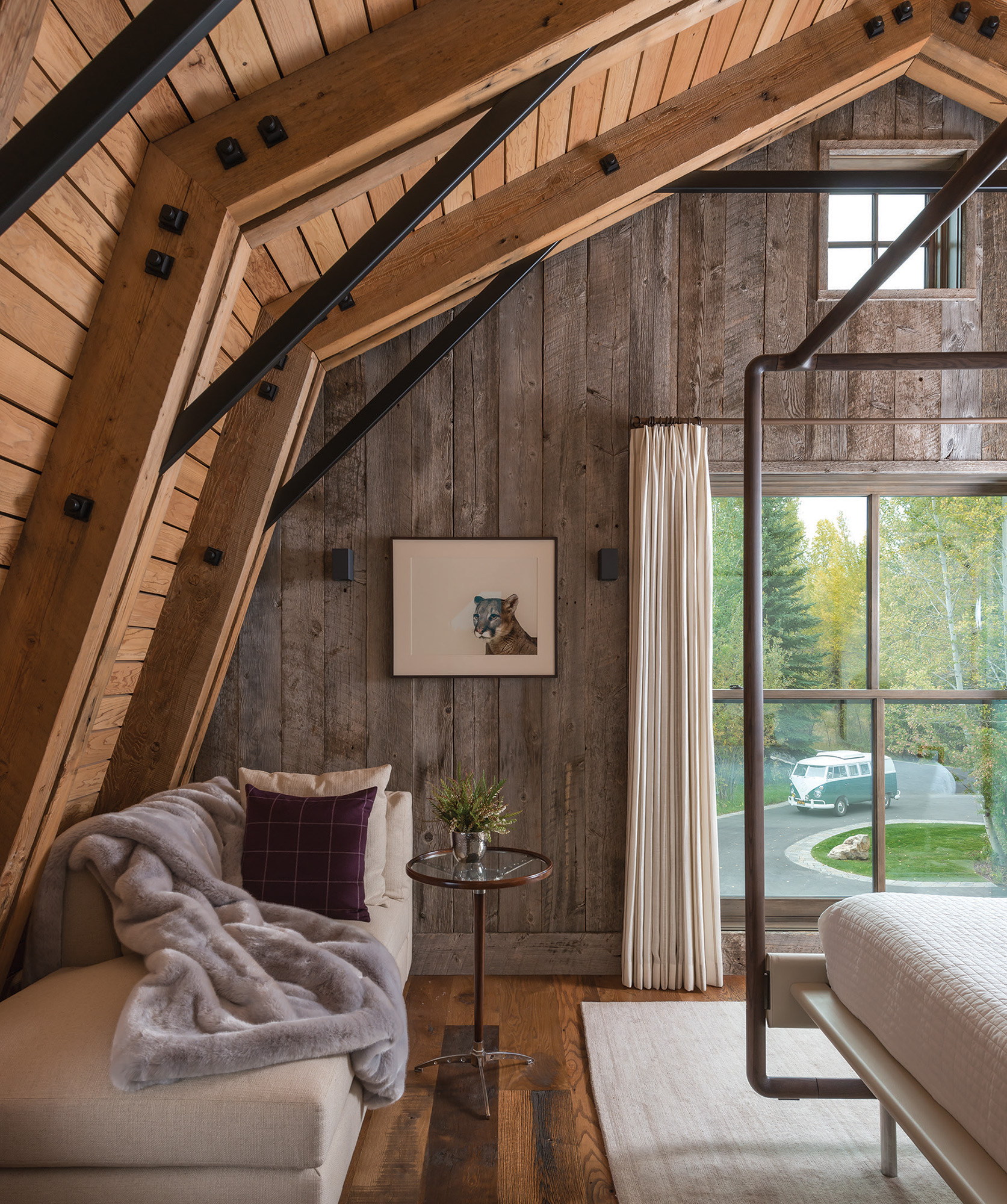
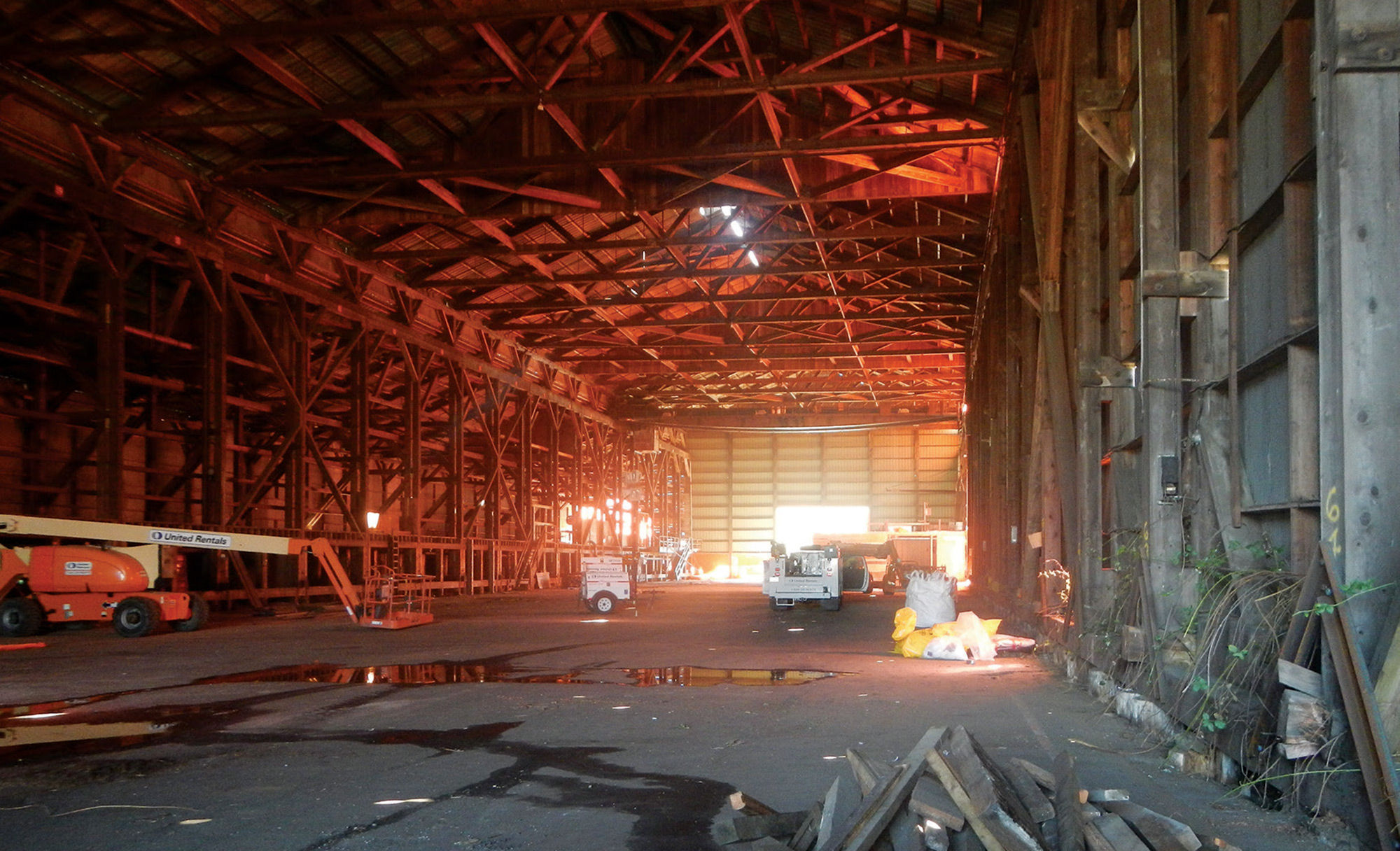

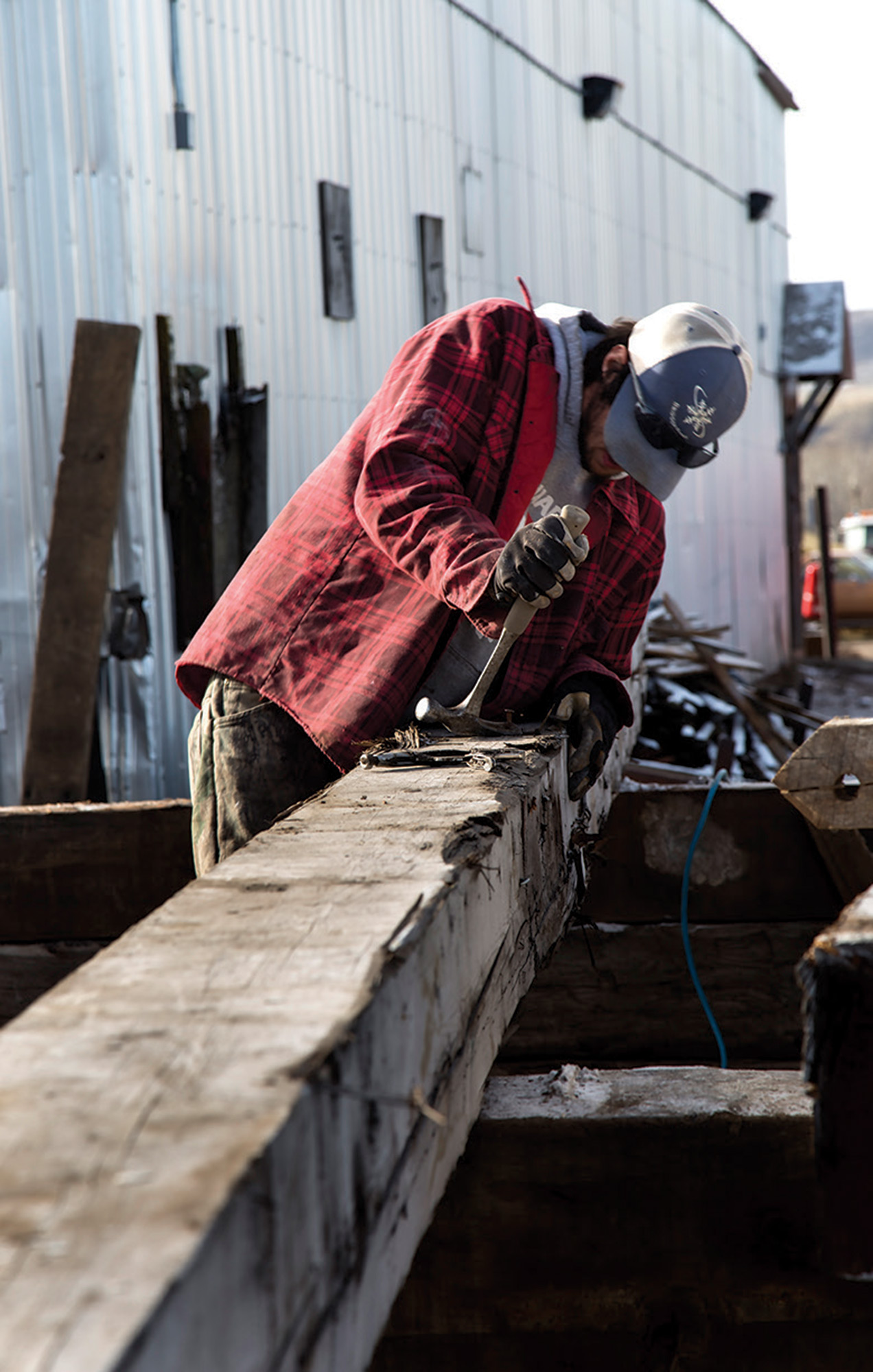
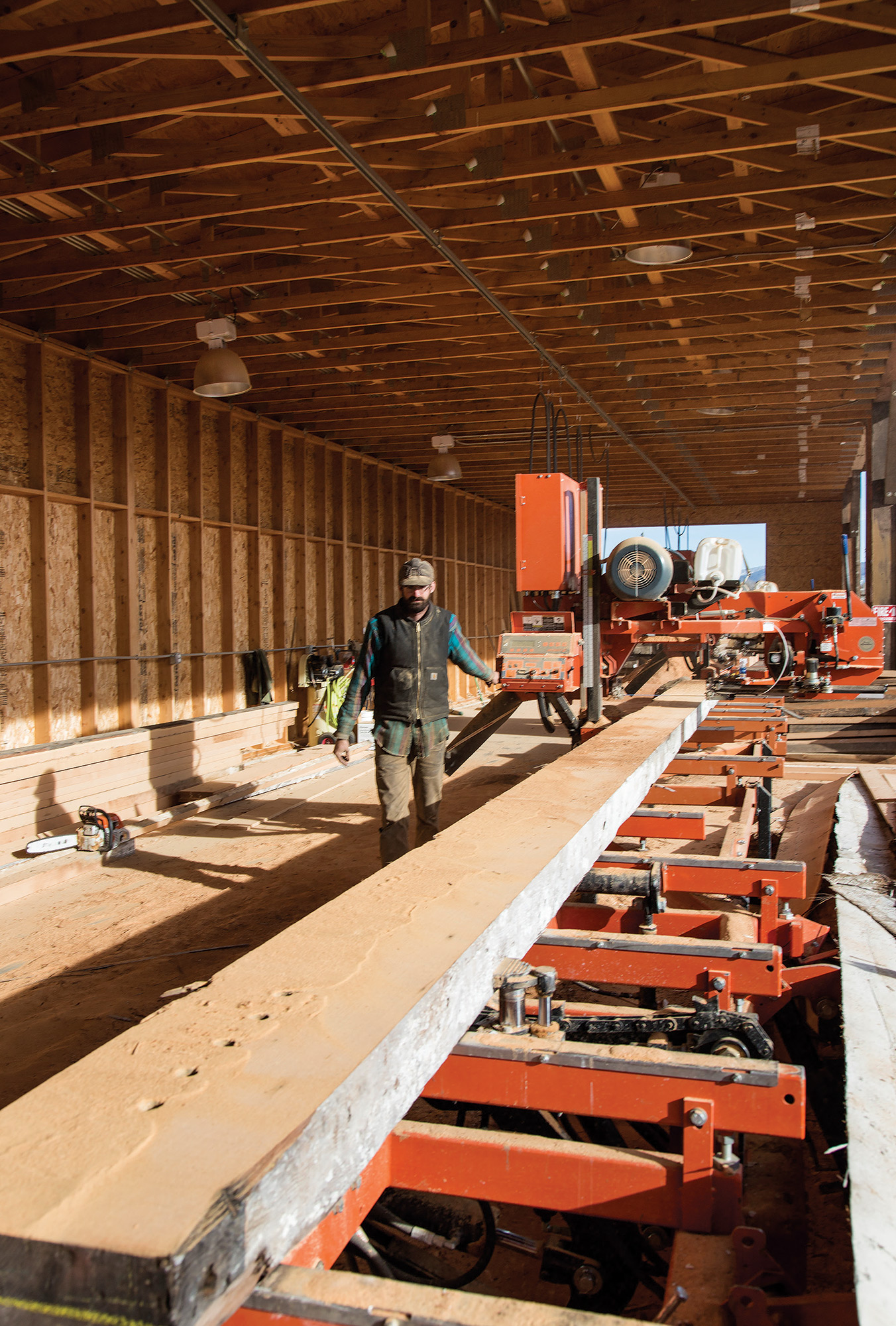

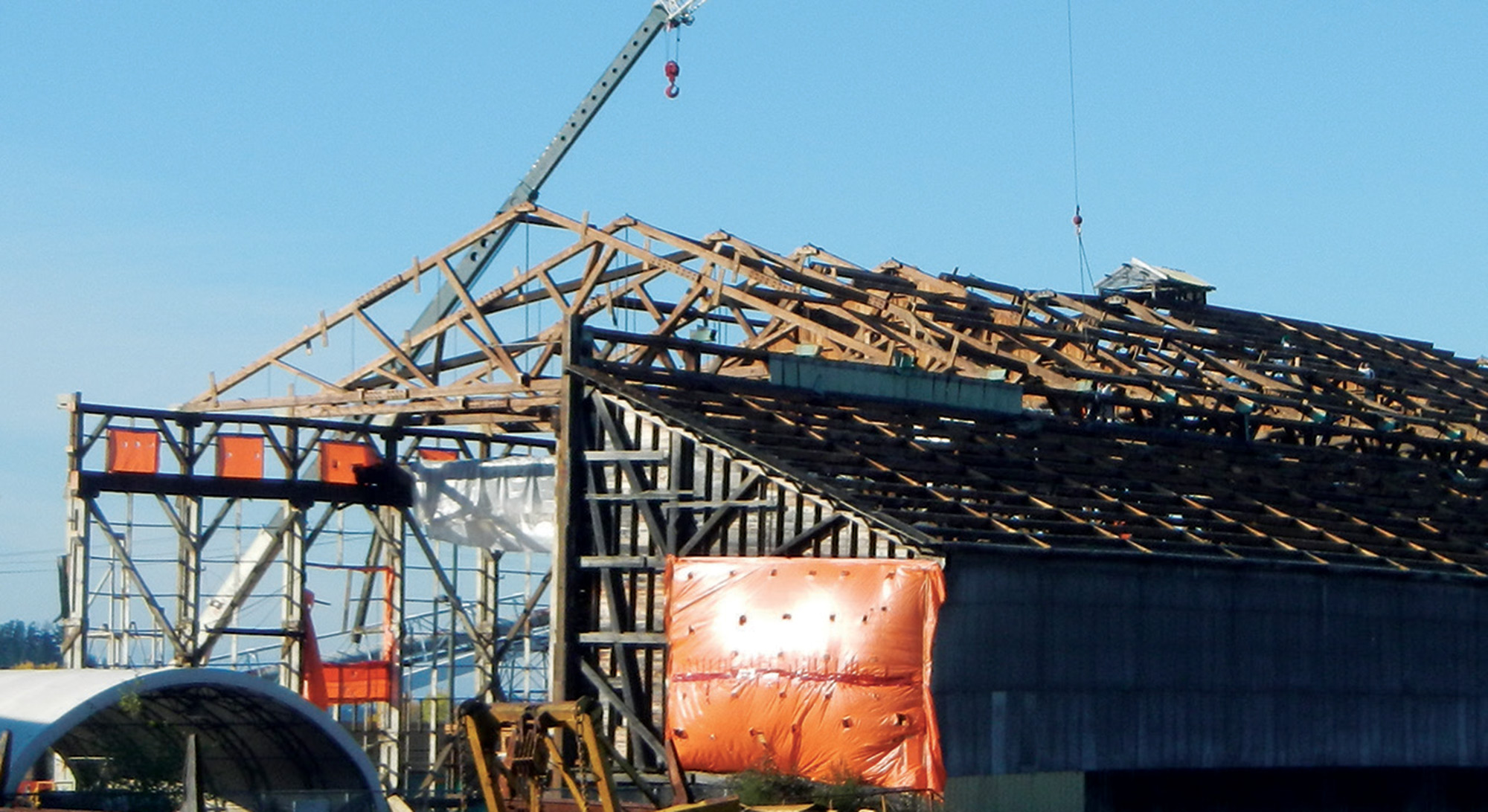
No Comments